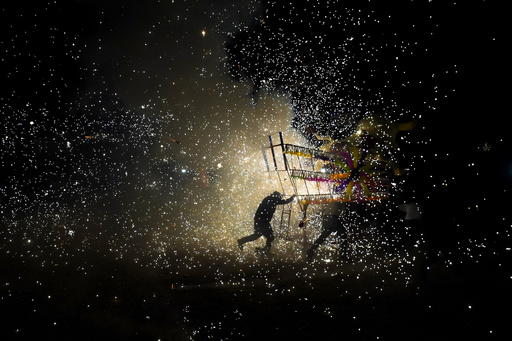TULTEPEC, Mexico (AP) — Every year, in the first week of March, hundreds of giant papier-mâché bulls stuffed with fireworks are erected in the front yards of the Mexican town of Tultepec.
Thousands of restless fingers carefully cut, pasted and painted the colorful patterns that brought the “toritos” to life on Friday, during an annual celebration when the bull-shaped figures were set alight.
Thousands of people gathered to dance and dodge amid the bulls as roman candles and bottle rockets showered them with sparks, and spinners nipped at their legs. Many wore heavy cotton clothes soaked in water to protect themselves against burns.
Unlike past occasions, the nighttime lighting of the bulls didn’t take place in the streets of Tultepec, but rather in an open field nearby.
The crowd packed into the field saw a mix of moments, with some running from angry fire-spitting bulls, like a pyrotechnic version of the running of the bulls festival in Pamplona, Spain.
Then, it turned into a kind of mass rave where people, mostly young men, danced, jumping up and down to the odd beat of fireworks going off and chanting “Fire! Fire! Fire!” under a rain of sparks and smoke.
The celebration, now its 35th year, pays homage and thanks the patron saint of the poor and sick, St. John of God, who the fireworks’ producers — a mainstay of the town’s economy — view as a protective figure.
But the festivities are also a way for the town of Tultepec, just north of Mexico City, to keep their craft alive and draw people to the town after a massive, devastating explosion at the workshops in 2018 killed 25 people and wounded twice that number.
One of the best-known workshops is the family-run business, Los Chavitos, which has been producing cardboard figures for fireworks for 15 years. Their figures range from very small bulls to giant ones, to figures of saints and imaginary animals known as alebrijes.
Every year, the workshop produces hundreds of smaller “bulls,” with roman candles for horns that are carried on someone’s shoulders through the streets of countless small towns in Mexico, sending kids skittering in delight. The shop also produces “Judas” figures of villains and politicians that are traditionally burned during Easter Week in Mexico.
But the big, standing bulls of Tultepec mark the high point of the year. Tultepec was one of the first places that began to produce gunpowder in Mexico during the colonial period, because of the town’s abundant supply of saltpeter, a key ingredient. Today, the town is affectionally known as “the capital of pyrotechnics.”
Francisco Cortes Urbán, 51, has been a fireworks artisan as long as he can remember. He learned the craft at the age of 12 and has passed his knowledge to his sons.
Cortes moved about frantically this week, taking calls, giving instructions and carrying small toritos from one corner of the workshop to the other. Clients were waiting for him to deliver.
In the background, a giant bull with colorful pre-Hispanic decorations shined under the sun, where a group of young artisans were busy with the final touches. Once the bull was finished, they had to secure a base on top of it, to hold approximately 1,000 fireworks that exploded when they were lit during the festival.
Every March 8, about 300 monumental papier-mâché bulls are hauled into the streets of Tultepec, as an offering to accompany the figure of St. John in an iconic procession. Smaller bulls also participate, splashing the sky with colorful explosions.
Of course, there were concerns about the safety of it all, but locals were too attached to the beauty of the tradition to worry too much.
“Every kind of work has a risk. This also has its risk,” said Cortes. “But we are passionate about it, and it has become our life.”



